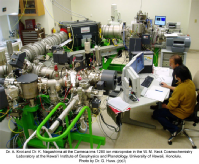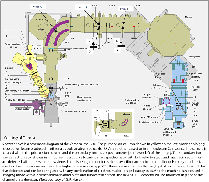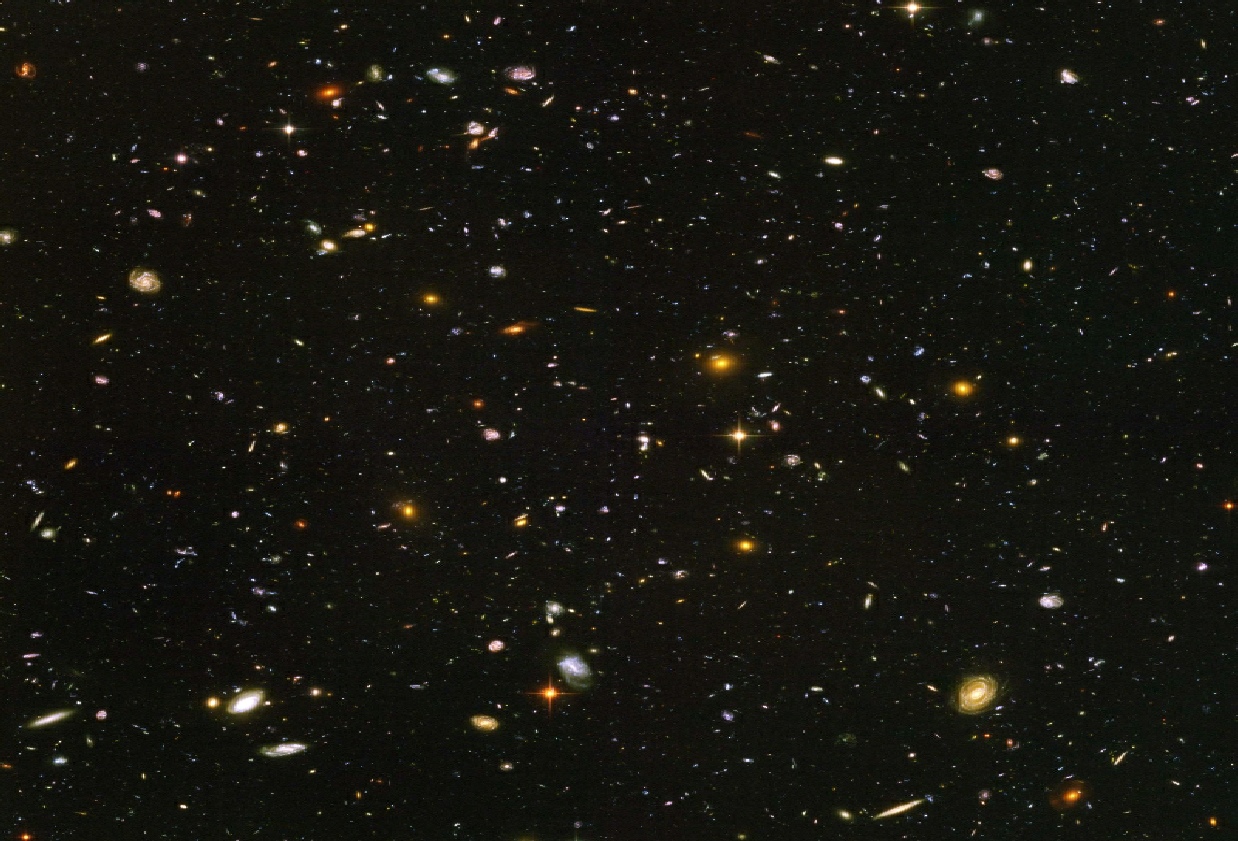W. M. Keck Cosmochemistry Laboratory in Hawaii
The W. M. Keck Cosmochemistry Laboratory supports interdisciplinary research into
the origin of the solar system through detailed studies of a variety of materials
including meteorites, interplanetary dust particles (IDPs), and samples returned
by NASA missions.
Fichier: Sasha and microprobe.jpg
Our broad research themes:
- Presolar grains and comet dust,
- Mixing of reservoirs
and processing of materials in the early solar system,
- Early solar system chronology
by measuring decay products of short-lived radionuclides. 
The centerpiece of the
lab is a new Cameca ims 1280 ion microprobe, installed in 2006.
The Cameca ims 1280 (shown above, left, and on the right in schematic format) is
the newest incarnation of the large-geometry Cameca ion probe (Conty, 1990). It uses
a new generation of electronics to control the voltages in the primary-ion column
and secondary-ion mass spectrometer. It has improved magnet control, including an
improved Hall probe system and a new NMR system. It as computer control of all slits
and apertures, new computer routines to improve reproducibility, and improved ion
detectors. These new features give the 1280 better performance than earlier machines.
as computer control of all slits
and apertures, new computer routines to improve reproducibility, and improved ion
detectors. These new features give the 1280 better performance than earlier machines.
We will upgrade this highly capable instrument with additional state-of-the-art technologies
to address the unique challenges of research on early solar-system materials. We
will add a secondary-electron detector to aid in locating tiny grains for analysis.
The secondary-electron image in the ion microprobe can be directly correlated with
the secondary-electron image from an SEM. To help precisely position the sample under
the primary beam during automated analyses and to facilitate using sample locations
determined by an automated system on the SEM, we will add optical encoders to the
sample stage. In collaboration with Prof. Yurimoto of Hokkaido University, Japan,
we will add a new type of two-dimensional, solid-state detector called SCAPS (Nagashima
et al., 2001; Yurimoto et al., 2003). Kazuhide Nagashima, a member of our research
team, is a co-developer of this unique detector. The SCAPS detector will permit direct
ion imaging of fine-grained samples and will permit identification of isotopically
or chemically anomalous grains at a spatial resolution of a few tenths of a micron
(Nagashima et al., 2004; Kobayashi et al., 2005).
Origin of the Solar System
We will
use the Cameca ims 1280 and associated equipment to investigate the origin of the
solar system. The research can be thought of as consisting of three basic types of
investigations: 1) Studies of the raw materials that were the building blocks for
the solar system, including presolar grains from meteorites, interplanetary dust
particles, and comet samples returned by the Stardust mission. 2) Studies of the
timing of events during the formation of the solar system. Chronology will be investigated
through studies of short-lived radionuclides. 3) Studies of early solar system processes,
which we will investigate through measurements of chemical compositions, trace-element
abundances, isotopic fractionations, and the unique variations exhibited by oxygen
isotopes.
In addition to the laboratory work, our studies will have strong interdisciplinary
collaborations with the astronomers and astrophysicists at the Institute for Astronomy
at the University of Hawaii and around the world, and with the University of Hawaii
Astrobiology Institute.
The people responsible for the success of the W. M. Keck
Cosmochemistry Laboratory
- Gary R. Huss, Laboratory Director and Researcher in Cosmochemistry. With 15 years
of experience with Cameca ion probes at both Arizona State University and Caltech,
Dr. Huss joined the University of Hawaii in February, 2005.
- Kazuhide Nagashima, Laboratory Manager and Researcher in Cosmochemistry. Dr. Nagashima
joined the University of Hawaii in June of 2005. He has worked extensively with the
Cameca ims 1270 at Tokyo Institute of Technology, where he helped to develop the
SCAPS detector.
- Sasha Krot, Researcher in Cosmochemistry. Dr. Krot has worked extensively on understanding
the origin of the solar system using petrology, short-lived radionuclides, and oxygen
isotopes.
- HIGP colleagues, all researchers in cosmochemistry, involved with the Laboratory:
Klaus Keil Ed Scott G. Jeffrey Taylor






 as computer control of all slits
and apertures, new computer routines to improve reproducibility, and improved ion
detectors. These new features give the 1280 better performance than earlier machines.
as computer control of all slits
and apertures, new computer routines to improve reproducibility, and improved ion
detectors. These new features give the 1280 better performance than earlier machines.